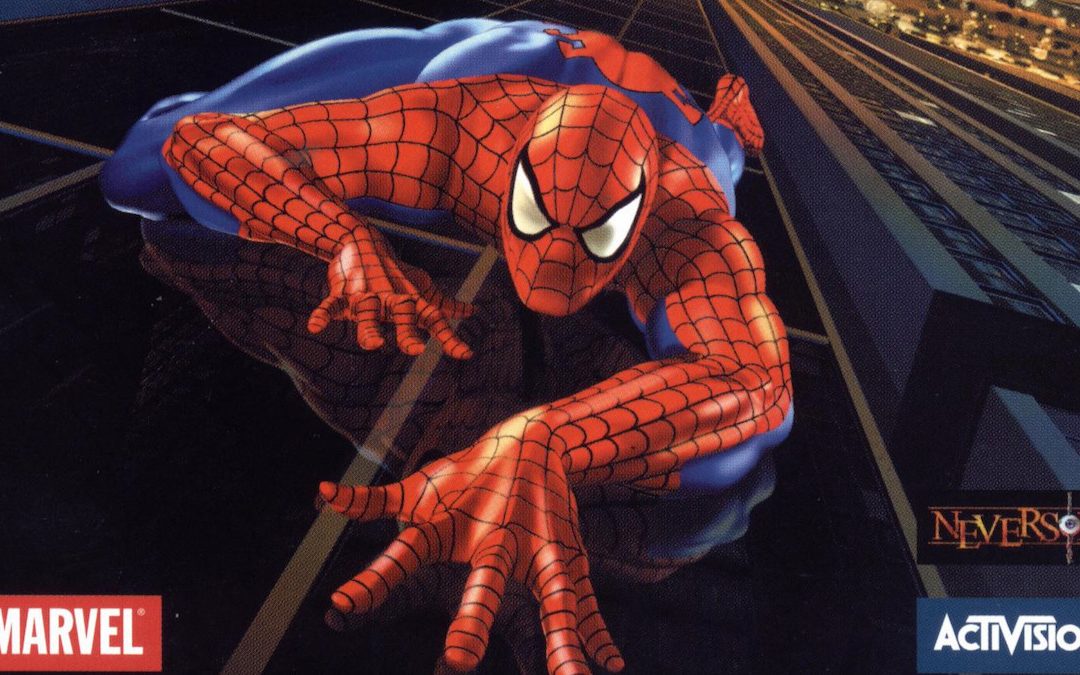As we are apparently entering the final days of the current console generation, now is a good time to remind gamers everywhere to not stare so intently at the future that you end up overlooking some of this generation’s best titles. That might sound like a strange warning, but without fail, the final years of a console yield truly great games that fail to attract the attention they deserve. It’s a trend that robs some games of their legacy. It’s also a big part of the reason why 2000’s Spider-Man for PS1 isn’t often remembered as one of the greatest superhero games of all-time.
Released in the UK during the September of the year 2000, Spider-Man arrived at a time of transition for pretty much everyone involved with the project. Developer Neversoft had just released the revolutionary Tony Hawk’s Pro Skater the year before and hadn’t yet become a studio largely responsible for pumping out skateboarding sequels. Publisher Activision had begun making some of the acquisitions that would eventually turn it into one of the most successful game publishers in the world. Marvel, meanwhile, was still trying to recover from its December 1996 bankruptcy filing and had begun looking for more ways to expand the brand (which included the release of the historically important superhero films, Blade and X-Men).
Yet, the most important name in this conundrum is PlayStation. By the time that Spider-Man for the PlayStation was released in North America and Europe, the PlayStation 2 had already been released in Japan and was generating the kind of hype worthy of a system that would go on to become the best-selling video game console of all-time. While the PlayStation 2 wouldn’t be released in North America until October 2000 – and Europe in November 2000 – the mere allure of its arrival was strong enough to effectively kill Sega’s Dreamcast, which had launched just one year prior.
Sega’s beloved final console wasn’t the only victim of PlayStation hype, though. Indeed, many PlayStation games released in 2000 failed to garner the attention that they might have otherwise received had they arrived a year or two prior. That left major titles like the brilliant Final Fantasy IX, the true cult classic Vagrant Story, the all-time great Tony Hawk’s Pro Skater 2, and even big-name sequels like Driver 2 fighting for the affection – and money – of gamers who were just crossing off the days until the PS2 arrived.
In the middle of that pandemonium was Spider-Man. While the famous web-slinger’s big-name status did help the game’s mere existence garner a certain level of hype, you have to remember that this was before the release of the 2002 Spider-Man film and a decade before the Marvel Cinematic Universe was a thing. Neversoft’s most-anticipated game of 2000 was Tony Hawk’s Pro Skater 2. The Spider-Man name on the jewel case just didn’t have the drawing power you think.
Of course, if Spider-Man had been a true once-in-a-lifetime great video game, it would have broken through all of those barriers and captivated the gaming world. That’s one thing we should probably get out of the way now, though. Spider-Man isn’t an undisputed great game.
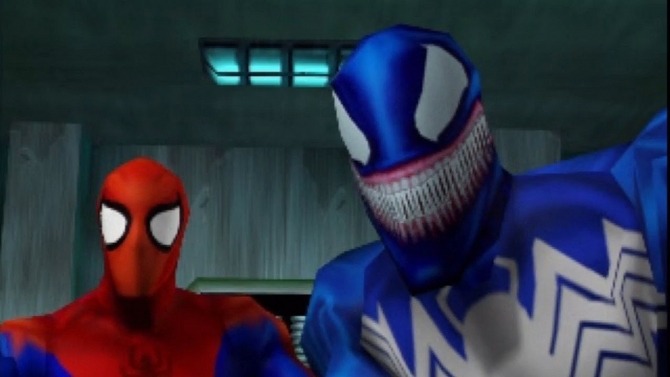
In fact, it’s hard to imagine any modern gamer finding it in themselves to get past the game’s visuals and other technological shortcomings. In one of those strange twists of fate that can only exist in this complicated little world we’ve made for ourselves, those shortcomings can largely be attributed to Neversoft’s desire and ability to push the abilities of the PlayStation to its final limits.
The result is a game that is both incredibly ambitious and technologically handicapped. Neversoft clearly wished to create a Spider-Man game that allowed players to truly experience the thrill of controlling Spider-Man in rich 3D playgrounds. It was a fine goal, but even after developers had explored just about everything the PlayStation could do, they hadn’t yet discovered how to use the console to create vast worlds that didn’t require a considerable number of design compromises.
Chief among those compromises is the “fog” that rolls across many of the game’s outdoor environments. Yes, much like Silent Hill, Spider-Man finds a way to work fog into the plot in order to compensate for the PlayStation’s terrible draw distance. No in-game excuses are made for the simply rendered character models, stunted animations, or for Spider-Man’s painfully limited ability to swing around the game’s levels. As for Spider-Man’s 3D combat… well, this was before Batman: Arkham Asylum showed the world how great brawler battles in 3D action games could be.
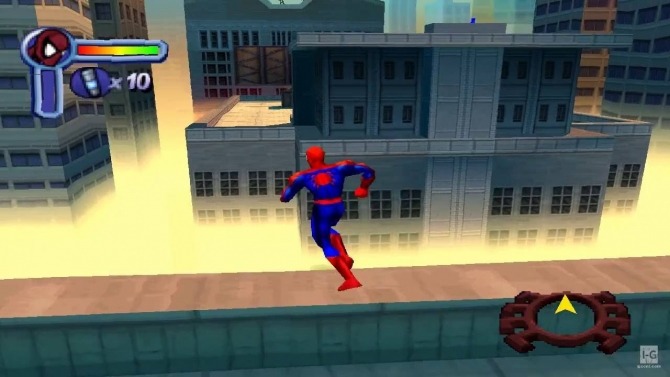
All of those limitations would have sunk Spider-Man were it not for one crucial design element that even the most powerful consoles can’t always instil in a game: the passion the studio had for the character. See, it turns out that the developers at Neversoft were huge Spider-Man fans. In fact, there are many times when the game’s core plot – some trifling mess involving an imposter Spider-Man – feels like the best available excuse the developers could come up with to work some of their favourite Spider-Man villains and Marvel heroes into the game.
What keeps the whole thing from feeling like a misguided piece of fanfiction is the sheer joy of it all. In the game’s very first level, we are greeted by narrator Stan Lee – who was doing Stan Lee cameos before Stan Lee cameos were cool – run into Black Cat, swing by the Fantastic Four headquarters, and get to hear J. Jonah Jameson scream at Spider-Man even as The Scorpion threatens to kill him. From there, players encounter Daredevil, Venom, Carnage, The Punisher, Captain America (who is caught playing cards with Spider-Man during a post-credits sequence), and even get references to and cameos from other Marvel characters like Thor, Wolverine, and Galactus.
In case you haven’t already gathered, many of the things that make Spider-Man so special are the same things that make the current MCU special. At a time when many Marvel and superhero games were still seen as an attempt to exploit the love fans had for these characters and their worlds, Spider-Man utilised that love not as an exploitative form of marketing but rather as the lifeblood of the experience. The name on the game said “Spider-Man” – and the game does do an excellent job of capturing the spirit of that character – but it was more than that. Spider-Man was truly a grand celebration of the Marvel universe that a generation of people who grew up on Marvel perhaps didn’t yet realise they needed in their lives. In fact, a large part of what makes the game unique to this day is the way that it draws much of its inspiration from Marvel comics.
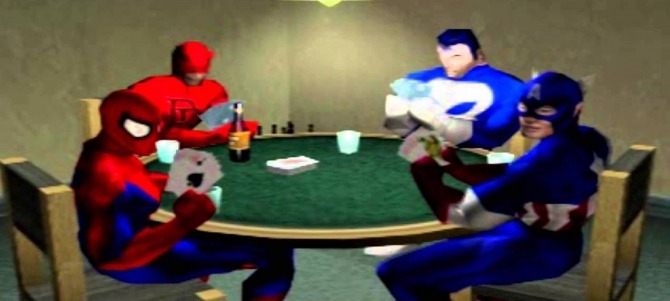
Spider-Man is about as far removed from the idea of a “gritty superhero reboot” as you can get. No attempts are made to hide the inherent absurdity of Spider-Man comics or Spider-Man: The Animated Series, which the game also borrows heavily from. Venom alternates between being a true threat and comedic relief. Rhino is a dumb thug with a fondness for forward momentum. By the time Doc-Ock and Carnage merge in the final level and the mechanical tentacled abomination starts chasing Spider-Man through an exploding building, you won’t even bat an eye at the ridiculousness of it all.
While the technical shortcomings of Spider-Man might frustrate modern gamers, the comic book charms of the game have lost none of their initial appeal. Few superhero games released since Spider-Man have truly endeavoured to recreate the style and tone of their comic book sources – 2005’s Ultimate Spider-Man is one of the few that comes close, while 2018’s Spider-Man PS4 went for more of a remix than a homage – and none have really tried to recreate the “Golden Age” feel of Spider-Man.
That design deficit in Spider-Man PS1 doesn’t diminish the sheer love from shining through. You can see it in everything from the various unlockable costumes (which double as a museum of Spider-Man’s history) to the game’s brilliant “What If?” mode (which pays tribute to the world of alternate Marvel universes by presenting the game’s main story in ways that slightly change several scenarios).
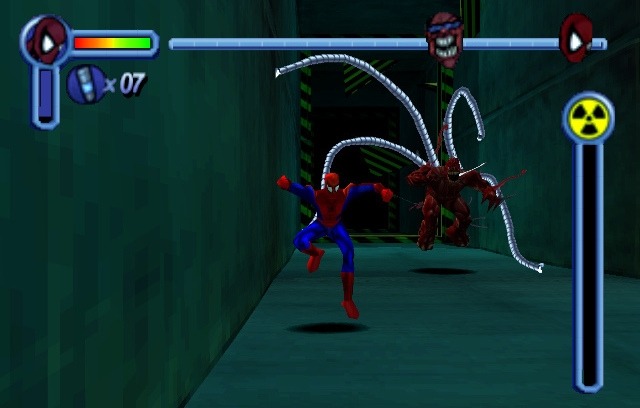
That’s the true tragedy of Spider-Man’s hidden gem status. This game never really got the chance to innovate and inspire other superhero game developers to pursue digital recreations of comic book worlds as it should have. Instead of becoming a classic of the genre and inspiring heaps of imitators, this game was shunned into the underrated pile as the industry charged into the PS2 era.
Later games like Freedom Force, LEGO Marvel Super Heroes, and even Viewtiful Joe would draw from a similar well to Spider-Man PS1, but the majority of major superhero games released since – including the Arkham series – aimed for something far more cinematic.
While it’s hard to fault the results of that approach (the PS2 adaptation of the cinematic Spider-Man 2 is rightfully remembered as one of the best superhero games ever for its brilliant open-world web-slinging), you can’t help but feel that something has been lost by the industry’s willingness to so quickly abandon the more whimsical nature of classic comics in favour of the continuing pursuit of more mature expressions of the superhero genre.
You do see love in the details still – like the huge volume of Easter Eggs in Spider-Man PS4, for example – but it’s rare that you see a superhero game embracing the primary coloured wackiness that you’ll find in a lot of classic comics.
Maybe that’s Spider-Man PS1’s true legacy. Rather than arguing its merits as one of the greatest – and certainly most underrated – of superhero games, perhaps it’s time that we salute this title as one of gaming’s greatest love letters to the comic book medium. We may never see its like again…

